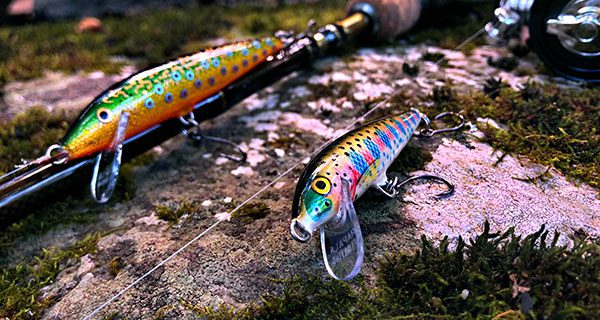Spin Fishing for trout is a really fun way to fish, and this is coming from someone that spends most of the guide season teaching people how to fly fish. While fly fishing, overall, is by far the most effective way to catch trout out of any other fishing technique, there is something nostalgic about throwing a spinning rod that reminds me of the times I spent trout fishing as a kid. Coming from the fly fishing world, I understand the effectiveness that a Rapala or Rooster tail can have on trout that are keying in on baitfish. Particularly, when searching for larger fish or targeting fish during high water. Here, I’ll go over the gear that I use, and ways that you can use a spinning rod to maximize your time on the water chasing trout while doing it in a way that doesn’t harm the fish.
I personally like rods in the 6’-6” to 7’ range in actions, from ultra light to medium, when targeting trout with spinning gear. I also find that I tend to have a better hook up ratio with a rod that has a slight moderate action that can help to absorb the shock being placed on relatively light line. Reels in the 1,000 – 3,000 range are all applicable, depending on the size of water/ trout that you are going to encounter the most. For line, it’s hard for me to beat Sufix Advanced Monofilament in 4-8 pound test for manageability and knot strength. I also always use braid as a backing on all my spinning reels to improve the overall sensitivity.
I never use live bait on trout or, frankly, with any fish I target. Mainly because with live bait, there is always a greater mortality rate with fish gut-hooking themselves more often than with artificial baits. In my experience, the most productive artificial lures I’ve used for trout have been more “old school”. I love throwing an Original Floating Rapala or Rooster Tail, as they are effective, in their own right, in mimicking the natural baitfish forage that is present in the Southern Appalachians. The Original Floating Rapala has a wobbling action that is very seductive to fish, and it’s buoyancy, due to being made out of balsa wood, causes it to deflect off of rocks and cover with ease. The Rooster Tail throws off excess vibration that can excel in murky/ high water conditions while having that extra “sound” for trout to pick up with their lateral line. I stick to more natural colors that best mimic the baitfish forage here but I find that, in most cases, color doesn’t matter as much as presentation. These are lures best fished with longer casts at a 45-degree angle to the bank. This allows for the lures to have the right action against the current while also having the most natural swimming action. This also gives the bait a much longer time in the water as it is being retrieved, increasing your chances of a trout being willing to move out of cover to ambush the bait. One thing that has to be noted is that you’re primarily targeting bigger fish in a river system with this technique rather than numbers. A trout’s diet is 90% aquatic insects, but bigger trout will start to change their diet to incorporate more baitfish once they hit the 16” mark. While the numbers of trout that are landed will not always be substantial, the size and quality of fish will be.
Spin Fishing has accrued a bad reputation for “hurting” trout, primarily from the use of treble hooks. Most conventional lures come stock with treble hooks already on the bait, and this is contested in many fishing circles as to their effectiveness/ ability to harm fish. I always switch out my treble hooks with VMC 7327 Inline Single 1x Saltwater hooks. These hooks are sharp, strong and, in my experience, will do a better job with hooking trout than a traditional treble hook. Treble hooks are, by nature, larger and can do a number on a trout’s jaw, decreasing their overall chances for survival. I’ve also found my hook up ratio increases with single hooks because I’ve watched trout “bounce” off of bulkier treble hooks when swiping at a Rapala or a Rooster Tail. As always, practice safe catch and release practices with trout when removing hooks by keeping them in the water and handling the fish as little as possible.
I could write an entire book on this subject, but I hope that this provides some insight on how to maximize your time on the water when targeting trout with spinning gear. Fill free to reach out to us at Southern Appalachian Anglers with questions or to seek further advice, we’re always available to help anglers, of all types and skill levels, to excel in their fishing abilities.
Ethan Hollifield is an Environmental/Physical Science Teacher and is also a guide for Southern Appalachian Anglers.
